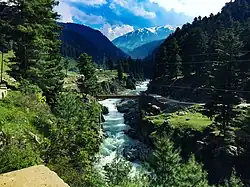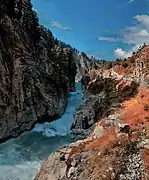Kulgam
Kolgom | |
|---|---|
Town | |
 | |
 Kulgam Location in Jammu and Kashmir, India  Kulgam Kulgam (India) | |
| Coordinates: 33°38′24″N 75°01′12″E / 33.64000°N 75.02000°E | |
| Country | |
| Union territory | Jammu and Kashmir |
| District | Kulgam |
| Government | |
| • Type | Democracy |
| • Body | Govt. of Jammu & Kashmir |
| • Chairperson DDC | Muhammad Afzal Parray[1] |
| Area | |
| • Total | 18.51 km2 (7.15 sq mi) |
| Elevation | 1,739 m (5,705 ft) |
| Population | |
| • Total | 23,584 |
| • Density | 1,300/km2 (3,300/sq mi) |
| Languages | |
| • Official | Kashmiri, Urdu, Hindi, Dogri, English[5][6] |
| Demographics | |
| • Literacy rate | 69.2% |
| • Sex ratio | 871.0 ♀/ 1000 ♂ |
| Time zone | UTC+5:30 (IST) |
| PIN CODE | 192231,[7] |
| Telephone code | 01931 [8] |
| Vehicle registration | JK18 [9] |
| Website | https://kulgam.nic.in/ |
Kulgam (Urdu pronunciation: [kʊlɡaːm]), known as Kolgom[10] (Kashmiri pronunciation: [kɔlɨɡoːm]) in Kashmiri, is a town, an administrative division and capital of the Kulgam district in the Indian union territory of Jammu and Kashmir. It is located at a distance of 67 km (42 mi) from the summer state capital of Jammu and Kashmir, Srinagar. The city is divided into 16 electoral wards that has a population of 23,584, of which 12,605 are males while 10,979 are females.[11]
Geography
The partial excavation of an archaeological site in a nearby village called Kutbal has yielded cultural material from the period of Kushan rule in the region.[12][13] Stamped tiles, which were excavated from the site, indicated the taste and living standard of the population.[14][15] "These excavations speak of high culture, civic sense, social norms and art of the people living in first century AD."[16]
Demographics
As of the 2011 Indian census, Kulgam had a population of 23,584.[17][2][3] There were 12,605 males (53%) and 10,979 females (47%).[2] Of the population, 3,353 (14.2%) were age 0-6: 1,787 males (53%) and 1,566 females (47%).[2] The literacy rate for the people over six was 69.2% (males 80.7%, females 56.1%).[2]
| Year | Pop. | ±% p.a. |
|---|---|---|
| 1911 | 1,795 | — |
| 1961 | 4,599 | +1.90% |
| 1971 | 6,369 | +3.31% |
| 1981 | 8,202 | +2.56% |
| 2001 | 13,136 | +2.38% |
| 2011 | 23,584 | +6.03% |
| Source: [3] | ||
Sightseeing
Kulgam is located about 68 km from Srinagar and about 17 km from Anantnag. It is connected with its neighboring districts like Shopian, Pulwama, Anantnag, Ramban etc. through roads besides being linked with far flung areas of the District by a dependable road network. Apart from places of spiritual interest the district also has tourist spots like the Aharbal waterfall on Veshaw River, Amnoo Eidgah which is a place of sight-seeing in the extreme south-west of district Kulgam, Kongwattan and Gurwattan ahead of Aharbal, Charenbal and Nadimarg high land pastures are also places of tourist attraction apart from virgin meadows in the area from Kund to Ladigasan (ahead of Aharbal clefts). The District also has super abundance of natural water resources in the shape of various famous springs such as, Kausar Nag (ahead of Aharbal), Waseknag (Kund), Khee Nag (Khee Jogipura), qaimoh nag (qaimoh) etc.
Transport
Road
Kulgam has following roads connecting it to various assembly segments and with NH1A (Major District Roads)
- Anantnag-Ashmuji-Brazloo-Kulgam Main Road
- Kulgam-Chawalgam-Muhammad Pra - Shopian Road
- Wanpoh-Qaimoh-Kulgam Road
- NH1A Mirbazar to Kulgam via Akhran, Hablishi, Kilam, Pirpora & brazloo
- Qaimoh-Kadder-Hanjan-Shopian Road
- Bijbehara-Arwani-Frisal-Yaripora Bugam-Kulgam Road
- Qazigund-Devsar-Pahloo-brazloo-Kulgam Road
- Kulgam-Shopian Road
- Kulgam-Nehama-Aharabal Road
- Kulgam-Damhal—Aharabal Road
- Kulgam-Damhal- Aharabal Road
- Kulgam-Ardigatnoo-Laisoo Road
- Kulgam-Laisoo-Damhal Hanjipora Road
- Khudwani-Frisal-Zainpora Road
- Frisal-Damidallah-Buchroo Road
- Frisal-Kralchek-Nagharad road
- Frisal- Nawbal-Shamsipora-Batingoo Road
Rail
Kulgam is not accessible through railway. The nearest railway stations are Anantnag railway station and Qazigund railway station located at distances of 4 and 10-20 kilometers respectively.
Air
Kulgam doesn't have its own airport the nearest airport is Srinagar International Airport located at a distance of 85 kilometres.
Health
Photo Gallery
 Aharbal Fall
Aharbal Fall Aharbal
Aharbal
See also
References
- ↑ Ashiq, Peerzada (6 February 2021). "BJP-Apni Party combine dents Gupkar Alliance's DDC prospects". The Hindu.
- 1 2 3 4 5 6 7 District Census Handbook Kulgam, Part B (PDF). Census of India 2011 (Report). 16 June 2014. pp. 22–23. Retrieved 11 February 2021.
- 1 2 3 4 5 A-4 Towns And Urban Agglomerations Classified By Population Size Class In 2011 With Variation Since 1901. Office of the Registrar General & Census Commissioner, Ministry of Home Affairs, Government of India (Report).
Class - III Population of 20,000 and 49,999 (Report). - ↑ "Kulgam Population Census 2011". census2011.co.in. 2011 Census of India.
- ↑ "The Jammu and Kashmir Official Languages Act, 2020" (PDF). The Gazette of India. 27 September 2020. Retrieved 27 September 2020.
- ↑ "Parliament passes JK Official Languages Bill, 2020". Rising Kashmir. 23 September 2020. Archived from the original on 24 September 2020. Retrieved 23 September 2020.
- ↑ "Pincode Search". Archived from the original on 20 August 2016. Retrieved 10 July 2016.
- ↑ "Kulgam, Srinagar, JK - STD Code: 01931". Archived from the original on 26 February 2019. Retrieved 7 August 2014.
- ↑ "Fares". Archived from the original on 22 November 2016. Retrieved 24 November 2016.
- ↑ Kashir Encyclopedia (in Kashmiri). Vol. 1. Jammu and Kashmir Academy of Arts Culture and Languages. 1986. p. 207.
- ↑ "2018 Municipal Polls In Brief". kashmirlife.net. Kashmir Life. 24 October 2018.
- ↑ Hussain, Tawqeer (30 October 2012). "Ancient Urban civilization Unearthed In South Kashmir, Left Unexplored". Retrieved 27 September 2019.
- ↑ Ahmad, Iqbal (24 March 2019). "Terracotta's of Kashmir". Retrieved 27 September 2019.
- ↑ Lone, Abdul Rashid. "Terracotta Art of Kashmir: An Overview". Sahapedia. Retrieved 27 September 2019.
- ↑ Lone, Abdul Rashid. "Early Historic Terracotta Art of Kashmir: A Photo Gallery". Sahapedia. Retrieved 27 September 2019.
- ↑ "History", District Kulgam, Government of Jammu & Kashmir, retrieved 20 February 2021
- 1 2 "Kulgam City Population". Census India. Retrieved 11 July 2021.
